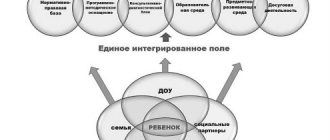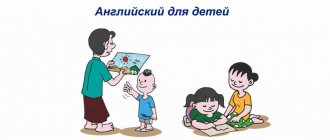Preschool children show special interest in the surrounding nature, its elements and phenomena. Home lessons on the topic “Seasons” should teach the child to distinguish the characteristic signs of spring, summer, autumn, and winter. It would be good if classes were based on joint observations and visual reinforcement of the material.
Folk signs in the living and inanimate nature of spring weather: words
Folk signs can be called a layer of all folklore. In such short phrases, our grandmothers tried to contain as much knowledge and life experience as possible, paying special attention to objects of living and inanimate nature. After all, everything in it is in a subtle relationship with each other.
- The early arrival of larks, rooks and cranes means that the weather will soon warm up
- even preschool children know that before the weather warms up, birds arrive from the south. Before frost, not a single flock will return to its native land. - Increased sap flow near the birch foreshadows a rainy summer - such wisdom has come to us from time immemorial. Therefore, if the opportunity arises, then take a closer look at the birch. She may promise a rainy summer.
- Bees fly out early, which means spring is already on the doorstep - bees are also heat-loving insects. Krasna is an old name for the word “beautiful”. And the beauty of spring is that everything in the area blooms and comes to life. This happens only after the cold weather has subsided.
- If you saw a cuckoo singing on a dry tree - expect frost - today it is not so easy to meet a cuckoo, but remember the folk sign if you hear its voice. Previously, they listened carefully to any signal and memorized them, since there were no weather forecasts yet.
Birds can also determine future weather
- If you see sparrows swimming, it means it will soon be very hot - even the birds are getting ready to welcome the warmth. After all, they know that they will have the opportunity to bask in the sun. You can’t force any animal to bathe before the cold weather.
- There are a lot of tits settling near houses, which means it won’t be warm soon - they are also looking for warmth, that’s why they hide near houses. After all, it will be warmer near them. When birds feel the onset of heat, they set up their new or old “homes”.
- A starling and a swallow on the street indicate warm weather soon - they do not appear until they are sure of a warm day tomorrow. Therefore, such a beautiful bird can also be used as a guide. If the weather is still planning frosts, then the swallow and starling will not appear.
- If you see a swallow low, prepare an umbrella - a well-known sign. And often such a remark was observed even by children.
Flowering shrubs in spring
All of them are photophilous and bloom under the forest canopy, when there is no foliage on the trees and shrubs.
In the life of some early flowering herbaceous plants of the forest, their growth under snow is very interesting. Plants such as scilla or snowdrop grow under the snow in winter.
In the spring, many of them emerge from under the snow with green leaves and buds that formed last fall.
Οʜᴎ often bloom before the snow melts 128 . That's why these plants are called snowdrops.
Plants that bloom in early spring always attract attention because they are beautiful and because they are the first plants to bloom after a long winter. Unfortunately, they are often collected in large bouquets. They often destroy entire plants by uprooting them. Plants whose flowering shoots are torn off do not produce fruits or seeds.
This makes it difficult for them to reproduce. Many of the plants have become very rare, for example, liverwort and sleep grass. We must not allow them to disappear completely. We are obliged to take care of the preservation of plants, not to tear them in order to throw them away every other day, not to damage wild plants and to actively protect nature.
Nature protection and rational use of the country's natural resources are legalized by the Constitution of Russia, i.e. are mandatory for all citizens of our country.
Trees and shrubs that are pollinated by insects bloom later, after the leaves have bloomed. If you observe the progress of spring from year to year, you will be able to establish the sequence of spring development of plants.
In the central European part of the USSR, usually 8 days after the coltsfoot flowering, lungwort begins to bloom, and 21 days later - dandelion and willow willow.
The pear blooms on the 29th day, the yellow acacia on the 30th, and the linden on the 75th day after the coltsfoot begins to flower.
Every year, spring phenomena occur in strict order. For example, lungwort always blooms later than coltsfoot, but before dandelion.
Observations of spring phenomena in plant life help to establish the best timing for agricultural work and prepare for it in a timely manner.
For example, it is known: in the regions of the middle zone, the best harvest of cucumbers is obtained by sowing their seeds during the flowering of lilac and yellow acacia, and the best harvest of turnips and beets is obtained by sowing them during the flowering of aspen.
Knowing how many days after the flowering of the coltsfoot lilac blooms, it is easy to set the date for sowing cucumbers and prepare for it.
Spring in pictures
To consolidate the knowledge the child has acquired, it is worth using illustrations on the topic “What spring it is!”
Available materials can include:
- thematic drawings;
- cut pictures;
- cards with images on the topic.
Illustrations may show:
- spring flowers;
- migratory birds;
- insects;
- Stories from the life of animals in the spring.
You can invite your child to draw spring as he imagines it, and then discuss the details of the drawing with him. It would be appropriate to learn several short poems on the topic with your child, and then select suitable images for them. You can make illustrations in the form of appliqués yourself using cut-out pictures. It’s good to prepare riddles about spring in advance along with the answers shown on small cards.
Children's cognitive abilities are maximized when using visual materials, especially if a serious lesson is taught in a light playful way.
Changes in nature
Not only people, but also all living beings sincerely rejoice at the arrival of spring: plants, animals, birds and even insects. With the advent of the first warm rays, young green grass and the first spring flowers - snowdrops - break through from under the snow.
TOP 4 articles
who are reading along with this
Winter
Water resources of our region
Living and inanimate nature (grade 2)
Winter phenomena in inanimate nature (grade 2)
The buds on the trees begin to swell and eventually turn into sticky young leaves. Fruit trees are especially beautiful in spring - in April-May they put on a white festive outfit and delight with the beauty and wonderful aroma of their flowers.
There are many signs associated with spring. For example, if it is warm in mid-March, then the summer will be warm, and a rainy April promises a rich harvest of mushrooms. The abundance of birch sap portends a wet and cool summer. Frequent rumbles of thunder in March foreshadow high wheat harvests.
Birds loudly welcome spring: wagtails, starlings, rooks, swallows. Forest birds notify the whole world with joyful trills about the imminent approach of warmth.
After the snow melts, the soil warms up so much that insects begin to wake up after a long winter hibernation. Ants and various bugs crawl to the surface, flies and caterpillars appear, and the first moths begin to flutter in the sky.
Rice. 3. Awakening of insects.
The animals exchange their warm fur coats for summer “outfits”, begin to create families, so that by the next winter they will have time to have offspring and teach the kids everything that they know and can do.
Natural phenomena in spring
Spring is a very bright event in the life of the surrounding world, so it occurs with many interesting and fascinating natural phenomena. These include:
• High water • Snowmelt • Ice drift • Thunderstorm • Hail • Bloom
In spring, the active melting of snow begins, and the cheerful murmur of streams is heard in the air. They fill rivers and lakes, causing them to overflow. The water overflows its banks and fills the banks, as well as forests and fields located nearby. This spring phenomenon is called "flood".
One of the earliest and most noticeable manifestations of spring is snowmelt. The sun, which is already high enough above the horizon and warms the earth well, melts the snow and turns it into winding streams.
When the ice on rivers and lakes begins to melt, it breaks into small pieces and is carried downstream. This phenomenon is called "ice drift". This kind of ice is very fragile, so it is very dangerous to walk on it in the spring.
The first thunderstorms appear in May. They have not yet gained their strength, but it is only a matter of time. Also in spring you can observe such an interesting natural phenomenon as hail. It represents balls of ice falling from the clouds. Hail varies in size. It can be the size of a bead or reach the size of a chicken egg.
One of the most striking phenomena of spring is, of course, flowering. Already at the end of April, the swollen buds begin to gradually open and reveal their emerald leaves to the world, and the green, slender blades of grass, like soldiers, reach out to the warm rays of the sun. Soon the first flowers appear, hospitably opening their petals to greet the awakening insects.
May in the folk calendar
Photo: AiF/Yulia Osintseva
May 2. Nightingale day.
If the nightingale gathers to sing these days, spring will bloom together. The nightingale sang thoroughly - spring has begun to wane, and summer has begun to increase.
Article on the topic
Spring mood: March, April and May in painting and literature
May 7 - Savva and Yevsey Day
This oats, when your bare feet on the arable land do not feel cold.
A frog with a voice is oats.
May 8 - Mark the Keymaster Day
Mark is the keeper of the keys to the rain.
If the rain that began on this day continues until May 11, then the next three years will be very fruitful.
A green rainbow means good harvest rains, a high rainbow means good weather for a month, a low rainbow means bad weather.
May 10 - Day of Semyon the Early Tiller
Don't be lazy with the plow, you'll end up with a pie.
There are flaws in the arable land - there are holes in the pocket.
You cannot sing on this day - there will be a big loss, a crop failure, and all things will go badly this year.
May 11 – Mokey Wet
Wet on Mokea - expect an even wetter summer. If the sunrise is purple and it rains during the day, it means a wet, stormy summer.
Photo: AiF/Yulia Osintseva
Photo: AiF/Yulia Osintseva
May 15 – Pakhom Bokogrey
Pakhom came and smelled warmth. It’s warm in Pahoma - warm all summer.
May 30 – Isaac the Serpentine
“Every reptile creeps out of its holes” on Isaac the Serpentine.
Photo: AiF/Yulia Osintseva
"Spring comes gradually." 10 poems about March
AiF
AiF
AiF
AiF
AiF
AiF
AiF
AiF
AiF
AiF
May: trying on clothes
Description of nature at the beginning of May (I - II week)
May came into play and painted nature in its first bright colors. The trees are rapidly trying on new outfits, as if preparing for summer, and young grass has spread across the ground. The bees immediately got to work, fertilizing the flowers with nectar. From the first half of May, as soon as the sun is constantly giving off heat, the grass is rapidly turning green, and the trees begin to become covered with dense leaves. In just a week, the leaf cover increases several times.
At the very beginning of May, there is often a sharp drop in temperature, through-cold winds rustle, and occasionally there is a small amount of precipitation in the form of snow, which, however, quickly melts on the already warmed spring soil. It will be cold and there will be a sharp warming. With warming, the average air temperature in May rises to +10 +12° C. The bird cherry blossomed, the lilac immediately filled the air with the aroma, the apple tree opens its first flowers. Nature, as if a young girl is being transformed, trying on one dress or another. The nightingale's singing can already be heard. Spring is blooming, and the nightingale is already calling for summer.
May is walking in the folk calendar
“The sky is bright in May - the women in the hut are hot”
May solemnly walks across the earth, preparing it for fertility, decorating nature with elegant flowers and robes. Although the May warmth is still unreliable, it was not without reason that they said “May will deceive you and go into the forest,” cold weather still occurs, but as a rule, for a short time, just in time for the bird cherry blossoms. On Yegorye-Teploye, on May 6th, the first modest breath of summer arrives. May 8 - Mark invites flocks of songbirds, and then Yakov on the 13th gives May warm, windless nights.
Spring in Russian poetry
Another master of words who sang of spring was A.A Fet. When reading his poem “Spring Rain,” one gets the impression of being in the atmosphere of sunny spring and joy, as well as a feeling of rapid movement, like spring streams. Nature comes alive in spring in his works. It’s not for nothing that A.K. Tolstoy said that Fet’s poems smell of sweet peas and clover, and in them the smell turns into color. He was a true master of words.
It’s still light in front of the window, The sun shines through the gaps in the clouds, And a sparrow flutters with its wing, bathing in the sand. And from heaven to earth, the curtain moves, swaying, and as if in golden dust, the edge of the forest stands behind it. Two drops splashed onto the glass, the linden trees smelled like fragrant honey, and something approached the garden, drumming on the fresh leaves.
Read: Poems by Russian poets about spring
May: summer is just around the corner
Description of the nature of late spring (III - IV week)
Brief frosts at night may still occur, but, as a rule, by the 3rd-4th week of May the weather becomes dry and hot. The first rumbles of thunder and thunderstorms are noted. The sun is gaining momentum and, from morning to sunset, saturates the earth and the entire flora of nature with warm, often hot rays. By the end of May, along with the air, the earth quickly warms up and hot summer weather may set in.
Nature is in a hurry, there is very little time left until summer, we need to do everything in time. You won’t recognize the recent forest, you won’t recognize the preened birches, the aspens primly dressed in green, the fashionably decorated rowan trees. So far, only the oak tree is in no hurry to put on a new suit, but its time is not far when the branches will acquire leaves. And now the poplars are decorated with fragrant bows, they will soon bloom. The apple tree has unfolded in a festival of petals, the flowers are shining with young colors, and the dandelions are turning yellow in the meadows.
Foreyear of May in the folk calendar
“Spring rain raises bread. There's no need for rain in May"
Before our eyes, the grasses are blowing up, nettles are growing, and by Mavra, which is May 16th, it’s time to eat cabbage soup. Cabbage is planted on May 18th, this is Arina the Rassadnitsa day. Now it’s time to fill the small furrows of the spicy soil with cucumber seeds, May 19 - Job the Borage.
First thunderstorm. The sun suddenly darkened and the sky became overcast with heavy clouds. The dim sky is illuminated by flashes of lightning, and the first strikes of thunder rush through the forest frozen in fear. Nature needs rain showers; they wash the soil and prepare the soil for sowing. On May 22, they begin to sow the land in Nikolshchina. And by May 26, Lukerya-Komarnica brings the first mosquitoes. Well, finally the weather is good, warm and, at times, hot. Nature is ready for the new season. Hello summer!
Top 16 primroses among shrubs and trees
Ten days after the start of sap flow, swelling of the buds becomes noticeable, in which rudimentary shoots are located under the protective bud scales.
Photo: Tom Brandt
Wind-pollinated trees and shrubs bloom before they are covered with leaves, or at the very beginning of their development.
Alder and hazel are the first to bloom in the second half of April, and among those pollinated by insects, willow. The buds of the willow are tightly covered with brown scales that look like caps.
Having shed them, the buds look like fluffy balls consisting of hairs that protect the flowers from sudden fluctuations in temperature and rain.
In April, most of the trees are still bare, but the integumentary scales of the swollen buds are already moving apart, and the tailbones of the leaves appear from them. The appearance of leaves. The young leaves of some trees are covered with a sticky fragrant substance, while others have a fluff that protects them from the cold.
The light green color of the trees is tender and transparent at this time.
At the end of April, bird cherry and birch buds bloom; in the first half of May - buds of maple, yellow acacia, apple and pear trees, and then - oak and linden.
In late spring, in the second half of May, the real blossoming of spring begins. Bird cherry blossoms, at the same time - black currant, a little later - wild strawberries and fruit trees, lilac, rowan and most herbaceous plants.
In the last days of May, the fruits of aspen and willow ripen.
The petals of apple and lilac flowers fall off - spring ends, summer begins.
Biology Spring phenomena in plant life
Spring is the time for nature to awaken. According to the calendar, spring begins on March 1st. In nature, spring comes into its own with the beginning of sap flow in the trees, earlier in the south and later in the north on March 1.
The spring movement of sap in trees and shrubs is the first sign of spring. It occurs after the soil thaws and water from the roots begins to flow into all organs of the plant. At this time leaves yet.
Water, accumulating in the cells of plant stems, dissolves the organic substances stored in them. These solutions move to the swollen and blossoming buds . Already in early March, spring sap flow begins in Norway maple, earlier than in other trees, and a little later in birch.
The second sign of spring is the flowering of wind-pollinated trees and shrubs.
Gray alder is the first to bloom in the central European part of the USSR. Its flowers are inconspicuous, but the blooming earrings of staminate flowers are clearly visible 123 . As soon as you touch an alder branch with earrings, the wind picks up a whole cloud of yellow pollen.
Pistillate alder flowers are collected in small grayish-green inflorescences. Next to them, the dry, blackened cones of last year's inflorescences are usually clearly visible.
Almost simultaneously with the alder, the hazel tree, which you met in the fall, blooms.
The staminate flowers of hazel develop in inflorescences - complex catkins, and the reddish stigmas of pistillate flowers protrude from generative (flower) buds.
Early flowering of alder, hazel and other wind-pollinated plants is a good adaptation to life in the forest.
Bare leafless branches do not impede pollination. Pollen picked up by the wind is freely transferred from one plant to another.
The flowering of coltsfoot is also a sign of the coming spring. This perennial herbaceous plant grows in open, sunlit places, on railway embankments, river banks, steep slopes and cliffs.
As soon as the snow melts, its scaly stems appear - flower stalks with bright yellow inflorescences, similar to the inflorescences of dandelions 124 . Large leaves of coltsfoot grow after its fluffy fruits ripen and disperse.
Coltsfoot received its unusual name for the uniqueness of its leaves. Their underside is covered with white, soft, felt-like hairs, and the upper side of the leaves is smooth and cold.
Coltsfoot blooms in early spring, before the leaves bloom, perhaps because its thick, long rhizomes contain reserves of nutrients deposited in the summer of last year.
Feeding on these reserves, flower shoots and fruits are formed.
The third sign of spring is the flowering of perennial herbaceous plants in the deciduous forest. In the middle zone they bloom almost simultaneously with coltsfoot. The first to bloom in the forest are the noble liverwort with azure flowers and the lungwort, then the oak anemone and buttercup 125 , corydalis 119 , spring primrose 126 , spring primrose 127 .








